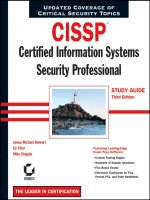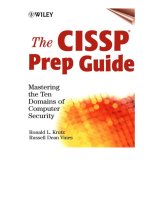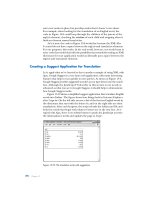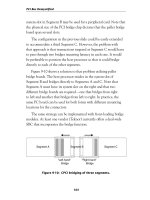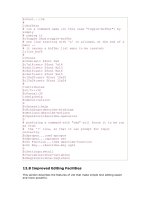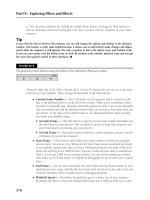The CISA Prep Guide Mastering the Certified Information Systems Auditor Exam phần 9 pps
Bạn đang xem bản rút gọn của tài liệu. Xem và tải ngay bản đầy đủ của tài liệu tại đây (458.79 KB, 60 trang )
15. The Annual Loss Expectancy (ALE) of a risk without controls is
expected to be $35,000 to a business process you are evaluating. You
are recommending a control that will save 80 percent of that loss at
an annual cost of $20,000 over the life of the process. Is the control
justifiable?
A. No, the savings is insignificant and relative to the cost.
B. Yes, 80 percent of the loss amounts to $28,000 per year, which
exceeds the annual cost by $8,000 per year.
C. No, ALE is a subjective number and cannot be depended on to
make this decision.
D. Maybe, it depends on the management’s appetite for risk and loss.
16. What is the most important aspect of risk analysis to keep in mind
when reviewing a business process?
A. Senior management must be held accountable for all risks to the
business.
B. All risks do not need to be eliminated for a business to be
profitable.
C. Risks must be identified and documented in order to perform
proper analysis on them.
D. Line management should be involved in the risk analysis because
management sees risks daily that others would not recognize.
17. Before making a recommendation to management for the further
mitigation of residual risk during a gap analysis in a risk assess-
ment, the following considerations should be decided upon:
I. Management’s risk tolerance
II. The best type of control for the risk scenario and the process
III.The gap between the acceptable risk and the residual risk
IV. The state of the art, best practice for the process being reviewed
V. Additional risk mitigation that the proposed control would
address for the process under review
A. I, II, III, and V only
B. II, III, and V only
C. II, III, IV, and V only
D. I, II, III, IV, and V
462 Chapter 7
18. What is the primary reason for independent assurance as a require-
ment for relying on control assessment and evaluation?
A. The review of controls by independent reviewers transfers some
amount of the risk to the reviewing body or organization.
B. IS auditors are more knowledgeable about risks and controls
and are better suited to review them and determine their
effectiveness.
C. Unless the controls are reviewed by an independent and objec-
tive review process, the quality of the controls cannot be assured.
D. Management needs to have independent assurance that the risks
are managed effectively as part of their corporate governance
requirement.
19. What are examples of additional risk to a business that a third party
may add to the overall risks of the business?
A. None, a business will actually take on some of the risk and
reduce the overall risks to the business.
B. A business will take on the risk that they do not have proper
processes in place to perform inefficiently.
C. A business will take on the risks that the contractual commit-
ments do not adequately compensate for poor performance
of the third-party vendor.
D. A business will take on the risk that the customers are impacted
by missed service level commitments or the misuse of customer
information.
20. When reviewing an audit function for independence, an IS auditor
would be most concerned to find that
A. The internal audit function was made up of people who used to
work for the external auditing firm that managed the accounting
and auditing of this business
B. The audit function had an administrative reporting relationship
to the controller of finance in the business
C. Some of the audit staff had previous involvement with the opera-
tion of business processes that their group was evaluating
D. The audit staff had reviewed similar risk and control processes
for competing businesses
Business Process Evaluation and Risk Management 463
465
Chapter 1—The IS Audit Process
Here are the answers to the questions in Chapter 1:
1. When planning an IS audit, which of the following factors is least
likely to be relevant to the scope of the engagement?
A. The concerns of management for ensuring that controls are suffi-
cient and working properly
B. The amount of controls currently in place
C. The type of business, management, culture, and risk tolerance
D. The complexity of the technology used by the business in per-
forming the business functions
Answer: B
The correct answer is B. How many controls are in place has little
bearing on what the scope of the audit should be. Scope is a defini-
tion of what should be covered in the audit. What management is
concerned about (A), what the management risk environment is (C),
Answers to Sample
Exam Questions
C H A P T E R
A P P E N D I X
A
and how complex the technical environment is (D) could all have an
impact of what the scope of a particular audit might be but not the
shear number of controls.
2. Which of the following best describes how a CISA should treat guid-
ance from the IS audit standards?
A. IS audit standards are to be treated as guidelines for building
binding audit work when applicable.
B. A CISA should provide input to the audit process when defend-
able audit work is required.
C. IS audit standards are mandatory requirements, unless justifica-
tion exists for deviating from the standards.
D. IS audit standards are necessary only when regulatory or legal
requirements dictate that they must be applied.
Answer: C
The correct answer is C. IS audit standards are mandatory to flow at
all times unless justification exists for deviating from them. Comply-
ing with standards is one of the tenants of the IS Audit Code of
Ethics and is not a guideline (A), does not apply only when the
work needs to be defendable (B), or when regulatory or legal issues
are involved (D).
3. Which of the following is not a guideline published for giving direc-
tion to IS auditors?
A. The IT auditor’s role in dealing with illegal acts and irregularities
B. Third-party service provider’s effect on IT controls
C. Auditing IT governance
D. Completion of the audits when your independence is
compromised
Answer: D
The correct answer is D. When the perception of auditor indepen-
dence is questioned, the audit management must investigate and
determine whether the situation warrants actions such as removing
the auditor or investigating further. There is no standard like the one
mentioned, but the subject is covered in the organizational relation-
ship and independence standard. The other answers are guidelines
provided by ISACA.
466 Appendix A
4. Which of the following is not part of the IS auditor’s code of ethics?
A. Serve the interest of the employers in a diligent loyal and honest
manner.
B. Maintain the standards of conduct and the appearance of inde-
pendence through the use of audit information for personal gain.
C. Maintain competency in the interrelated fields of audit and infor-
mation systems.
D. Use due care to document factual client information on which to
base conclusions and recommendations.
Answer: C
The correct answer is C. Use of client information is unethical and a
cause for revocation of your certification. The other three are tenants
of the code of ethics.
5. Due care can best be described as
A. A level of diligence that a prudent and competent person would
exercise under a given set of circumstances
B. A level of best effort provided by applying professional judgment
C. A guarantee that no wrong conclusions are made during the
course of the audit work
D. Someone with lesser skill level that provides a similar level of
detail or quality of work
Answer: A
The correct answer is A. Due care is a level of diligence applied to
work performed. It is a reasonably competent third-party test. It
does not ensure that no wrong conclusions are made (C) and is not
related on a skill level (D) but a competence and prudence level. It is
not a level of best effort (B). It is a benchmark to compare efforts
against—that which would have been done in similar circumstances
by a prudent and competent person.
6. In a risk-based audit approach, an IS auditor must consider the
inherent risk and
A. How to eliminate the risk through an application of controls
B. Whether the risk is material, regardless of management’s
tolerance for risk
Answers to Sample Exam Questions 467
C. The balance of the loss potential and the cost to implement
controls
D. Residual risk being higher than the insurance coverage
purchased
Answer: C
The correct answer is C. You do not want to eliminate risk (A), you
want to only manage and control it. Management’s tolerance of the
risk is part of the definition of what is material so whether the risk is
material (B) is not a correct answer. Insurance coverage is not neces-
sarily the only control to consider for mitigating residual risk (D).
The correct balance of cost to control any potential losses is a very
important part of the risk mitigation considerations.
7. Which of the following is not a definition of a risk type?
A. The susceptibility of a business to make an error that is material
where no controls are in place
B. The risk that the controls will not prevent, detect, or correct a risk
on a timely basis
C. The risk that the auditors who are testing procedures will not
detect an error that could be material
D. The risk that the materiality of the finding will not affect the out-
come of the audit report
Answer: D
The correct answer is D. Answer A is the definition of an inherent
risk, which is a risk in its natural state or without controls. A con-
trols risk (B) is the chance that controls put in place will not solve
the problem soon enough to prevent loss. A detection risk (C) occurs
when auditing does not discover material errors due to sampling or
testing procedures.
8. What part of the audited businesses background is least likely to be
relevant when assessing risk and planning an IS audit?
A. A mature technology set in place to perform the business
processing functions
B. The management structure and culture and their relative depth
and knowledge of the business processes
468 Appendix A
C. The type of business and the appropriate model of transaction
processing typically used in this type of business
D. The company’s reputation for customer satisfaction and the
amount of booked business in the processing queue
Answer: A
The correct answer is A. All of the items listed are relevant, however,
by itself the maturity of the technology has the least amount of bear-
ing on the risk assessment of an organization. Just because it is a
mature technology does not mean it is inherently risky or does not
meet the needs of the business.
9. Which statement best describes the difference between a detective
control and a corrective control?
A. Neither control stops errors from occurring. One control type is
applied sooner than the other.
B. One control is used to keep errors from resulting in loss, and the
other is used to warn of danger.
C. One is used as a reasonableness check, and the other is used to
make management aware that an error has occurred.
D. One control is used to identify that an error has occurred and the
other fixes the problems before a loss occurs.
Answer: D
The correct answer is D. While both are after the fact (A), the order
of application is not really relevant. While corrective controls keep
errors from resulting in loss (B), detective controls do not warn,
deterrent controls do. While reasonableness checks can be a detec-
tive control, it also is used to make errors known (C).
10. Which of the following controls is not an example of a pervasive
general control?
A. IS security policy
B. Humidity controls in the data center
C. System-wide change control procedures
D. IS strategic direction, mission, and vision statements
Answers to Sample Exam Questions 469
Answer: B
The correct answer is B. The other three are pervasive because
they focus on the management and monitoring of the overall IS
infrastructure. Humidity controls are specific to a single data
center only.
11. One of the most important reasons for having the audit organization
report to the audit committee of the board is because
A. Their budgets are more easily managed separate from the other
budgets of the organization
B. The departments resources cannot easily be redirected and used
for other projects
C. The internal audit function is to assist all parts of the organiza-
tion and no one reporting manager should get priority on this
help and support
D. The audit organization must be independent from influence from
reporting structures that do not enable them to communicate
directly with the audit committee
Answer: D
The correct answer is D. Independence from influence and for
reporting purposes is the primary reason to have reporting lines
outside of the corporate reporting structure.
12. Which of the following is not a method to identify risks?
A. Identify the risks, then determine the likelihood of occurrence
and cost of a loss.
B. Identify the threats, their associated vulnerabilities, and the cost
of losses.
C. Identify the vulnerabilities and effort to correct based on the
industry’s best practices.
D. Seek managements risk tolerance and determine what threats
exist that exceed that tolerance.
Answer: C
The correct answer is C. The industry’s best practices must be tem-
pered by management tolerance for risk and their direction. The
elimination of risks is not your goal. Risk is only relevant to man-
agement’s needs.
470 Appendix A
13. What is the correct formula for annual loss expectancy?
A. Total actual direct losses divided by the number of years it has
been experienced
B. Indirect and direct potential loss cost times the number of times it
might possibly occur
C. Direct and indirect loss cost estimates times the number of times
the loss may occur in a year
D. The overall value of the risk exposure times the probability for all
assets divided by the number of years the asset is held
Answer: C
The correct answer is C. Annual loss expectancy is the total losses
both direct and indirect times the frequency of occurrence for that
loss in a given year.
14. When an audit finding is considered material, it means that
A. In terms of all possible risk and management risk tolerance, this
finding is significant.
B. It has actual substance in terms of hard assets.
C. It is important to the audit in terms of the audit objectives and
findings related to them.
D. Management cares about this kind of finding so it needs to be
reported regardless of the risk.
Answer: A
The correct answer is A. Materiality is a relative, professional judg-
ment call that must take into context management’s aggregate toler-
ance of risk, how this finding stacks up to all of the findings, and the
potential cumulative effect of this error.
15. Which of the following is not considered an irregularity or illegal act?
A. Recording transactions that did not happen
B. Misuse of assets
C. Omitting the effects of fraudulent transactions
D. None of the above
Answer: D
The correct answer is D. None of the above is not an auditing irregu-
larity or a possible illegal act based on the definition in the standard.
Answers to Sample Exam Questions 471
16. When identifying the potential for irregularities, the auditor should
consider
A. If a vacation policy exists that requires fixed periods of vacation
to be mandatory
B. How much money is devoted to the payroll
C. Whether the best practices are deployed in the IS environment
D. What kind of firewall is installed at the Internet
Answer: A
The correct answer is A. While the others have varying relevance to
audit testing, they do not indicate possible irregularities by them-
selves. A vacation policy that does not require staff to be away from
work for a fixed period of time—usually one to two full weeks—
enables employees to maintain fraudulent schemes without requir-
ing a trained back up employee to step in and perform the process
for at least some period of time during the year.
17. Some audit managements choose to use the element of surprise to
A. Scare the auditees and to see if there are procedures that can be
used as a back up
B. Ensure that staffing is sufficient to manage an audit and daily
processing simultaneously
C. Ensure that supervision is appropriate during surprise inspections
D. Ensure that policies and procedures coincide with the actual
practices in place
Answer: A
The correct answer is A. Some of the other answers are nonsensical,
but the real reason for using the element of surprise is to ensure that
the policies and procedures documents line up with actual practices.
18. Which of the following is not a reason to be concerned about auditor
independence?
A. The auditor starts dating the change control librarian.
B. The auditor invests in the business spin-off of the company.
C. The auditor used to manage the same business process at a
different company.
D. The auditor is working as consultant for the implementation por-
tion of the project being audited.
472 Appendix A
Answer: C
The correct answer is C. The fact that this was their job at another
company may actually be an advantage for the audit team. The
other items listed could lead to a compromise of the auditor’s
independence and should be investigated.
19. Control objectives are defined in an audit program to
A. Give the auditor a view of the big picture of what the key control
issue are based on the risk and management input
B. Enable the auditor to scope the audit to only those issues identi-
fied in the control objective
C. Keep the management from changing the scope of the audit
D. Define what testing steps need to be performed in the program
Answer: A
The correct answer is A. The scope is not defined exclusively by the
auditor (C) and does not necessarily define testing the related tasks
(D). Answer B is somewhat correct; however, Answer A is the best
answer.
20. An audit charter serves the following primary purpose:
A. To describe the audit process used by the auditors
B. To document the mission and business plan of the audit
department
C. To explain the code of ethics used by the auditor
D. To provide a clear mandate to perform the audit function in
terms of authority and responsibilities
Answer: D
The correct answer is D. The charter’s main purpose is to define the
auditor’s roles and responsibilities. It should evidence a clear man-
date and authority for the auditors to perform their work. Unlike a
mission statement (B) or a process document (A), it describes the
bounds of authority. The code of ethics (C) is a nonrelevant answer
to this exercise.
Answers to Sample Exam Questions 473
21. In order to meet the requirements of audit, evidence sampling
must be
A. Of a 95 percent or higher confidence level, based on repeated
pulls of similar sample sizes
B. Sufficient, reliable, relevant, and useful, and supported by the
appropriate analysis
C. Within two standard deviations of the mean for the entire popu-
lation of the data
D. A random selection of the population in which every item has an
equal chance of being selected
Answer: B
The correct answer is B. Sampling satisfies the evidence require-
ments that the data is sufficient, reliable, relevant, useful, and sup-
ported by the appropriate analysis. A random population section (D)
is the definition of a random sample. Answers A and C do not make
sense.
22. Audit evidence can take many forms. When determining the types
required for an audit, the auditor must consider
A. CAATs, flowcharts, and narratives
B. Interviews, observations, and reperformance testing
C. The best evidence available that is consistent with the importance
of the audit objectives
D. Inspection, confirmation, and substantive testing
Answer: C
The correct answer is C. The rest of the answers list types of audit
evidence that could be considered, but the auditor must consider the
best evidence available and determine what method for gathering
and reviewing it as a second step in the audit planning process.
23. The primary thing to consider when planning for the use of CAATs
in an audit program is
A. Whether the sampling error will be at an unacceptable level
B. Whether you can trust the programmer who developed the tools
of the CAATs
474 Appendix A
C. Whether the source and object codes of the programs of the
CAATs match
D. The extent of the invasive access necessary to the production
environment
Answer: D
The correct answer is D. There is no sampling error with CAATs,
which is one of their strengths (A), you will need to be aware of
other participants in the process but that should be under your con-
trol (B), and understanding whether the source and object code
match is an issue with what you are testing not to itself (C). The best
answer is that you should be concerned with the potential impact of
your testing on live data.
24. The most important aspect of drawing conclusions in an audit report
is to
A. Prove your initial assumptions were correct.
B. Identify control weakness based on test work performed.
C. Obtain the goals of the audit objectives and to form an opinion
on the sufficiency of the control environment.
D. Determine why the client is at risk at the end of each step.
Answer: C
The correct answer is C. Answer A is not value-added to the client;
neither is D unless there is a weakness identified first. Answer B is
an okay answer, however, Answer C is the best possible choice.
25. Some things to consider when determining what reportable findings
should be are
A. How many findings there are and how long the report would be
if all findings were included
B. The materiality of the findings in relevance to the audit objectives
and management’s tolerance for risk
C. How the recommendations will affect the process and future
audit work
D. Whether the test samples were sufficient to support the
conclusions
Answers to Sample Exam Questions 475
Answer: B
The correct answer is B. Materiality, audit objectives, and manage-
ment’s direction are the key items to consider. Answer D needs
resolving long before the findings are reviewed for reportability;
Answer A, how many, or Answer C, the effect of the recommenda-
tions, is not an issue with whether they should be reported or not.
26. The primary objective of performing a root cause analysis is to
A. Ask why three times.
B. Perform an analysis that justifies the recommendations.
C. Determine the costs and benefits of the proposed
recommendations.
D. Ensure that you are not trying to address symptoms rather than
the real problem that needs to be solved.
Answer: D
The correct answer is D. Answers B and C are not correct because
they are related to recommendations and not to the root cause.
Answer A is a technique used in root cause analysis. The best
answer is D.
27. The primary reason for reviewing audit work is to
A. Ensure that the conclusions, testing, and results were performed
with due professional care.
B. Ensure that the findings are sufficient to warrant the final report
rating.
C. Ensure that all of the work is completed and checked by a
supervisor.
D. Ensure that all of the audits are consistent in style and technique.
Answer: A
The correct answer is A. The other answers are all important but the
primary reason is one of ensuring due professional care by checking
the work with a reasonably competent third-party review.
476 Appendix A
Chapter 2—Management, Planning, and
Organization of Information Systems
Here are the answers to the questions in Chapter 2:
1. Which criteria would an IS auditor consider to be the most important
aspect of an organization’s IS strategy?
A. It includes a mission statement.
B. It identifies a mechanism for charging for its services.
C. It includes a Web-based e-commerce strategy.
D. It supports the business objectives.
Answer: D
The correct answer is D. While a mission statement (A) is certainly
a common component of a strategy documentation, and charging
mechanisms (B) can be included as a reference, the most important
item to consider is the alignment of the strategy with the business
needs and objectives. Web strategies (C) may or may not be relevant
to the business at hand.
2. From a segregation of duties standpoint, which of the following job
functions should be performed by change control personnel?
I. Verifying that the source and object code match before
moving code into production
II. Scheduling jobs to run in the production environment
III.Making changes to production code and data when
programs fail
IV. Applying operating system patches
A. I only
B. I, II, and III
C. II and IV only
D. I and IV only
Answers to Sample Exam Questions 477
Answer: A
The correct answer is A. Scheduling jobs (II) would provide a
change control person the opportunity to run jobs in combination
with the changes they are applying, thus permitting potential fraud
or the abuse of production processing. No direct changes to code or
data (III) should ever be permitted by a nonprogrammer who is not
acting on behalf of the application or user management. Job function
IV could be seen as a change control function, but these systems
level upgrades are typically applied by system programmers who
are qualified to perform these functions and to ensure they are
appropriately installed.
3. In a database management environment, which of the following
functions should not be performed by the database administrator?
A. Sizing table space and memory allocations
B. Testing queries and consulting on table join limitations
C. Reviewing logs for fraudulent activity or access errors
D. Performing back ups and recovery procedures
Answer: C
The correct answer is C. Sizing database relevant components (A),
testing queries and consulting on database access and views (B), and
performing back up and recovery functions are all part of the DBA’s
job. They should not have the responsibility for reviewing audit logs
(C) because they have access to modify the logs and are not inde-
pendent from a capability standpoint. Although they can always
change logs to cover up fraudulent activity, the role of review and
the assurance that the logs are not tampered with by DBAs should
fall to a supervisory position overseeing the DBA function.
4. Many organizations require employees to take a mandatory one to
two full weeks of contiguous vacation each year because
A. The organization wants to ensure that their employee’s quality of
life provides for happy employees in the workplace.
B. The organization wants to ensure that potential errors in process
or irregularities in processing are identified by forcing a person
into the job function as a replacement periodically.
478 Appendix A
C. The organization wants to ensure that the benefits provided by
the company are fully used to enable full employment of replace-
ment staff as much as possible.
D. The organization wants to ensure that their employees are fully
cross-trained and able to take over other functions in case of a
major disruption or disaster.
Answer: B
The correct answer is B. Employees in sensitive functions should be
required to take at least a full weeks vacation annually to ensure that
the opportunity for fraudulent or illegal activities are not perpetu-
ated by their uninterrupted daily attendance to systems or
processes. The other answers are all valid reasons for providing a
job rotation or vacation requirement, but Answer C is the best
answer from an audit perspective.
5. Which of the following would be most important in evaluating an IS
organization’s structure?
I. Human Resource policies that adequately describe job functions
and duties sufficiently
II. Organization charts that identify clear reporting and authority
lines
III.System configurations that are well documented in the system
architecture
IV. Training requirements and provisions for cross training that are
documented along with roles and responsibilities
A. I and II only
B. I, II, III, and IV
C. I, II, and IV only
D. II and III only
Answer: C
The correct answer is C. Important aspects of an IS strategy, of the
items listed, include Human Resource policies, organization charts
and clear authority lines, and training requirements. System config-
urations and architecture are not really related to the strategy of the
Answers to Sample Exam Questions 479
organization but more to its system design than strategic direction.
While training (IV) requirements are not as important in a strategy
document as I and II, it is still relevant and the best answer from an
audit perspective of those available.
6. In a review of Human Resource policies in an IS organization, an IS
auditor would be most concerned with the absence of
A. Requirements for job rotation on a periodic basis
B. A process for exit interviews to understand the employees’ per-
ception of management
C. The requirement for employees to sign a form signifying that
they have read policies
D. The existence of a termination checklist requiring that keys and
company property are obtained and all access permissions are to
be revoked upon termination
Answer: D
The correct answer is D. The first three answers are good practices to
be sure. But the revocation of access privileges and the ability to
retain company assets and physical access to property is the most
important item listed from an audit perspective.
7. A System Development Life Cycle can be best described as
A. A process used by programmers to document SOP 98-1 compliance
B. A methodology used to guide the process of software creation
project management
C. A system design methodology that includes all the steps in prob-
lem definition, solution identification, testing, implementation,
and maintenance of the solution
D. A process used to manage change control and approval cycles in
a development environment
Answer: C
The correct answer is C. SDLC methodologies are described by all of
the answers provided for this question to some extent. They can
guide in change control and approval cycles (D) and the project
management of software development. It also can be helpful when
analyzing capital- versus expense-related tasks related to develop-
ment projects, but Answer C best describes the SDLC components
and use as a design methodology.
480 Appendix A
8. What is the primary difference between policies and standards?
A. Policies provide a high-level framework and standards are more
dynamic and specific.
B. Policies take longer to write and are harder to implement than
standards.
C. Standards require interpretation and must have associated
procedures.
D. Policies describe how to do things and standards provide best
practices guidance.
Answer: A
The correct answer is A. Policies are intended to be high-level guid-
ance by senior management and should not change much over time,
while standards are more technology specific and therefore may be
more dynamic in nature. Policies are not necessarily harder to write
or implement (B) and do not describe how to do things (D), those
are called procedures. Policies may require interpretation and stan-
dards should be specific and clear for a given situation, which
makes Answer C a wrong answer.
9. Which of the following is not a standard?
A. Approved access control methodologies
B. How to request a new account
C. Minimum security baseline for hardening a UNIX server
D. Description of acceptable back up and recovery methods for
production data
Answer: B
The correct answer is B. How to request clearly spells out a step-
by-step process to follow, which is better described as a procedure.
Minimums (C), acceptable practices (D), and approved methods
(A) all imply standards documentation.
10. Which of the following are not key considerations when reviewing
third-party services agreements?
A. Provisions exist to retain ownership of intellectual property and
assets.
B. The lowest price possible is obtained for the service rendered.
Answers to Sample Exam Questions 481
C. Business continuity planning and processes are part of the signed
agreement.
D. Security and regulatory concerns are identified as risks during
negotiations.
Answer: B
The correct answer is B. Lowest cost does not always mean the best
arrangement especially from a control standpoint. Ensuring that
ownership is retained (A) for the intellectual aspects of the business
that would be needed, should the business eventually go to another
vendor, are very important to the survivability of the business. (C)
BCP processes are an important part of any third-part relationship
so alternatives are thought through and well documented before
disruptions occur. Additionally, even though it is more important
that security and regulatory concerns be addressed directly in the
wording of the final agreement signed by both parties, identifying
the issues in negotiations it is still more important than the lowest
price from an audit and risk perspective.
11. When evaluating project management, which of the following
would you be least concerned in seeing evidenced?
A. Well-defined project scope and objectives
B. Costs identified with the resources allocated to the project
C. Timelines with achievable milestones
D. Sponsorship and approval by business process management
Answer: B
The correct answer is B. All elements mentioned are important to a
successful project and need to be set in place to manage the project
successfully. In order of importance to the project, (D) sponsorship
and backing is the most critical element, without which you cannot
even get started. (A) Knowing where you are going through the
scope and objectives also is clearly a key piece in managing anything.
(C) Having a time frame documented to measure progress against is
necessary to understand the comparative success against manage-
ment’s expectations along the way. (B) Knowing what the costs will
be is important but may change through the course of the project,
depending on needs to expedite certain sections and on the availabil-
ity of resources. This can only be estimated throughout the project
and only becomes good information after the costs are realized.
482 Appendix A
12. When evaluating a change control process, the IS auditor would be
most concerned if he or she observed the following:
A. Change control personnel permitting systems programmers to
patch operating systems
B. Computer operators running jobs that edit production data
C. Application programmers correcting data errors in production
D. Change control personnel copying code from the production for
testing purposes
Answer: C
The correct answer is C. Programmers should never be permitted to
directly access data in the production environment. Computer oper-
ators will initiate, by nature of their function, programs that may
modify data (B). Systems programmers are permitted to patch sys-
tems and in fact, should be the ones performing this function (A).
The proper way to test production code is to first copy it from the
live production environment to minimize the impact on the user
community. No humans should ever directly manipulate the appli-
cation code or data in the production environment.
13. During the review of a problem management system, it is deter-
mined that several problems have been outstanding and unresolved
for an excessively long period. Which of the following reasons is
most questionable to the IS auditor reviewing the management con-
trols of this process?
A. The problem has been sent to the vendor who will send a fix with
the next software release.
B. The problem has been determined to be a user error and has
been referred to the business unit for correction and additional
training.
C. The problem is intermittent and after researching, remains out-
standing until reoccurrence.
D. The problem is seen as a low risk issue and is therefore low on
the priority list to be addressed.
Answer: D
The correct answer is D. The first three answers are all legitimate
reasons to have an outstanding problem on the tracking logs. How-
ever, problems can be misleading at first read, and it should never
Answers to Sample Exam Questions 483
be assumed that because of the way a problem is reported, it is
inconsequential. Many security breaches occur in this manner. Man-
agement should ensure that all problems are quickly investigated
and their root causes are determined. The need to prioritize prob-
lems for addressing them implies larger volumes than the organiza-
tion is equipped to handle, indicating other more severe control and
management issues.
14. During the problem analysis and solution design phases of an SDLC
methodology, which of the following steps would you be most con-
cerned with finding?
A. Current state analysis and documentation processes
B. Entity relationship diagramming and process flow definitions
C. Pilot testing of planned solutions
D. Gathering of functional requirements from business sponsors
Answer: C
The correct answer is C. The other three answers are all part of a
well-executed SDLC methodology used to design a system or soft-
ware. However, the initial problem analysis and design phases of a
development cycle are not the appropriate place for the testing of
solutions, especially by piloting them with end users.
15. What is the primary concern that an IS auditor should consider when
reviewing Executive Information Systems (EIS)?
A. Ensure that senior management actually uses the system to moni-
tor the IS organization.
B. Ensure that the information being provided is accurate and
timely.
C. Ensure that the information provided fairly summarizes the
actual performance of the IS organization so that indicators will
be representative of the detailed tracking and monitoring
systems.
D. Ensure that MTBFs are kept to a minimum and within acceptable
boundaries.
Answer: C
The correct answer is C. EISs must represent real-world information
in order for them to be most useful to management. They must
summarize the issues in production and enable management to get
484 Appendix A
indicators of the underlying problems that need further investiga-
tion. Mean time between failures (D) is only one aspect of informa-
tion monitoring. Having accurate and timely information (B) does
not help if the information that is being reported is not the key indi-
cator needed from which to best run the operation. It is up to man-
agement to use the system for it to be useful (A). Certainly, this is
reflective of how well management is performing their function, but
the quality of the information is the primary concern in a review of
the system.
16. SOP 98-1 is an accounting position that needs to be considered by
the IS auditor primarily because
A. The AICPA requires all auditors to be aware and comment on this
statement of position.
B. Management may be capitalizing software development tasks
that should be expensed.
C. Keeping track of development efforts from a capital and
expense perspective is indicative of good management of
IS organizations.
D. SOP 98-1 tracking systems are required to be interfaced directly
to accounting systems and may introduce opportunities for
fraudulent accounting.
Answer: C
The correct answer is C. The AICPA (A) provides this statement of
position as guidance and does not, in general, require auditors to do
anything unless it is required based on a risk analysis and professional
due care. Although it would be a concern if management was not
properly capitalizing development tasks (B), and this should be exam-
ined during the review, the use of this statement of position as an indi-
cator of the management processes is the primary aspect of reviewing
adherence to this advice. Direct interface with accounting systems (D)
is not a hard requirement of this type of accounting method.
17. When reviewing the management processes for overseeing budget-
ing and spending, the IS auditor should be least concerned with
which of the following items?
A. Ensuring that all spending is reconciled to a budgeted line item
and the variances to budget are explained
B. Ensuring that all of the budgeted money is spent in a budget year
Answers to Sample Exam Questions 485
C. Ensuring that expenditures are recorded and reported on bud-
gets to IS organizational management
D. Ensuring that SOP 98-1 provisions are adequately documented
and appropriately allocated
Answer: B
The correct answer is B. Spending all budgeted monies is of little con-
cern and in fact may be indicative of a well-run organization. The
other three items are all relatively important to meeting the functional
requirements of oversight and management of an IS organization.
18. When evaluating information security management, which of the
following are not items the IS auditor would consider commenting
on as a potential control weakness?
A. A security program had not been developed using a risk-based
approach.
B. The information security officer does not accept responsibility
for security decisions in the organization.
C. The use of intrusion detection technologies has not been consid-
ered for use in the security program.
D. Account administration processes do not require agreement to
acceptable behavior guidelines from all persons requesting
accounts.
Answer: B
The correct answer is B. This question uses double negatives to con-
fuse the CISA candidate. The answer is looking for the single item
that is acceptable and would not result in an audit concern. Valid
concerns include creating a security program without considering
risk (A), not at least considering intrusion detection technologies (C)
whether they are used or not depends on that analysis, and not
making account users aware of their security accountabilities and
responsibilities (D). It is not the position of the security management
to own the security decisions in an IS organization and (B) it would
therefore be considered an appropriate position for information
security management to take. That accountability lies with senior
management who make their decisions based on expert input from
486 Appendix A
